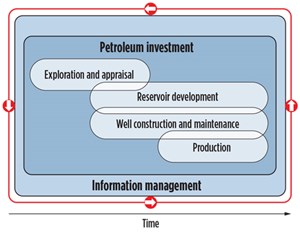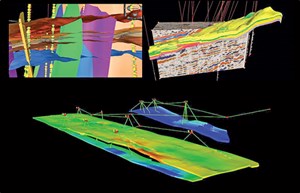Integrated asset management connects the dots for optimized field development
The oil and gas industry is going through an unprecedented downturn. Oil prices have tumbled around 65% over the last 20 months, forcing companies to cut deeper to weather the storm. Most top oil companies have reported sharp declines in profits. Additionally, executives at national oil companies (NOCs), international oil companies (IOCs) and oilfield service (OFS) firms face a conundrum: how to cut costs—and stay financially viable—while continuing to safeguard resources and infrastructure, so that their respective companies can both meet present demands and be ready when the market recovers. Efficiency and cost optimization are the key technical and strategic business drivers.
The upstream industry has lost a significant amount of talent and resources in the course of this downturn, challenging the legacy method of field development and asset management. Today, 70% of global oil/gas supply comes from mature fields, where production is declining and the water-to-oil ratio has increased to the alarming level of 9:1, thereby pushing companies to operate in deep water and unconventional assets, with complex geologies posing difficult, technical surface-subsurface challenges. Accurately understanding reservoir behavior is the key to business success, and in some cases, survival.
Smaller teams, fewer resources and technical challenges call for a renewed focus on integrated field planning and development strategies at every stage in the reservoir lifecycle. It is imperative that geoscientists and engineers work closely together—rather than the legacy method of working in silos—to address these challenges and provide a holistic view of the field. Thanks to the advancement of emerging digital technologies, asset teams now have tools for integrated E&P lifecycle management. These technologies enable teams to respond quickly to any technical or market conditions. For example, Landmark’s DecisionSpace Enterprise Platform provides a single platform for the integration of geoscience, reservoir, drilling, production and economics applications for collaboration in real time. The service company leads globally in many areas of oilfield service technologies: an acoustic Telemetry System obtains data from downhole sensors in real time; extended-service M/LWD sensors increase the ability of operators to collect downhole data in extreme conditions; intelligent completion technology optimizes completions without costly well intervention; and a collaborative, integrated workflow helps operators know where to drill, how to drill, where to frac and how to frac. DecisionSpace brings together all of these data, tools, technology and people to help achieve the best technical, operational and economic performance during the assets lifecycle, Fig. 1.
Building an accurate 3D model, to obtain a detailed description of the reservoir architecture, requires a combination of geological/geophysical interpretation, petrophysics and geomechanics in an earth model. This helps operators to explore new development concepts, and identify sweet spots and target wells to exploit the reservoir potential. DecisionSpace Geosciences combines workflows in a unified suite, without the need to import/export data. From constructing a framework, to reservoir characterization, building the geocellular model and dynamic modeling, multiple cycles of scenarios can be analyzed in a much shorter timeframe, thereby reducing the time to decision.
Developing models, either static or dynamic, is a critical process, but only one part in the larger cycle. Traditionally, the flow of information has been one way, but with present challenges, closed loop flow of information and data is paramount for success, incorporating rapid updates and refining models based on the most recent field data. DecisionSpace technology has helped make this a reality by allowing operators to visualize changes across the workflow to better manage and revitalize their well or field, Fig. 2. Globally, most fields are mature, which necessitates infill drilling or enhanced recovery techniques to produce from depleted reservoirs. There also has been an increased implementation of smart completions and multilateral wells, to improve recovery and prolong the lives of reservoirs. All of these techniques pose high costs to operators; therefore, modeling these scenarios accurately, before implementation, is crucial to avoid drilling into non-productive zones and implementing incorrect designs, which would reduce overall productivity.
Reservoir simulation provides the fundamental framework for field development and enables asset teams to meet short-term production targets and long-term objectives, of increasing sweep efficiency and maximizing ultimate recovery. Landmark’s Nexus reservoir simulation suite provides users with the ability to couple surface and subsurface flow models, utilizing historical data to explore alternative development strategies. Traditional approaches use multiple software suites to model subsurface and surface facilities separately, thereby leading to instabilities and non-convergence in the systems. However, the service company’s system delivers a fully implicit solution, to model both the subsurface and surface network in a single application. This includes modeling flow from pore spaces to the point of sale, while considering the impact of the proposed surface facilities design on production.
Surface facilities can significantly constrain production below a well’s actual potential, especially in complex networks, such as deepwater assets, where the platform may be miles away from producing wells. This becomes even more critical in multi-reservoir assets, where individual reservoirs are connected through a shared network, with each unit impacting the production of others. An integrated multi-reservoir model is required to accurately determine the interactions of these reservoirs, improving production and prolonging the life of the asset. Such solutions have been implemented in various parts of the world. They have, for example, improved asset designs and recovery rates for major operating fields in Latin America, with performance enhancements of up to 70% and as much as a 60% reduction in time spent on building and updating models. In the Middle East, full produced gas recycling into a multi-reservoir field has helped maintain pressure and significantly lowered recovery costs.
Recent budget reductions require more cost-effective development plans by incorporating cost analysis tools coupled with field development plans, thus maximizing potential from a technical and economic perspective. Integrated platforms facilitate an alliance of parties—those who design development strategies, those who implement them, and those responsible for operations—to make decisions faster and foster collaboration across domains.
Emerging digital technologies also are providing new avenues for upstream oil and gas. By utilizing the advanced digital echo-system of Silicon Valley, we are experiencing innovations to manage the volatile market and complex technical challenges. Landmark Earth Engineered Appliance (LEA) is one such example of this convergence. Deploying and managing petro technical applications is costly and requires significant manpower with specialized skills. LEA combines the latest science of converged infrastructure and E&P Blueprint with a pre-installed software suite and automatic updates.
Drilling analytics software is another example, allowing users to gain insight from historical drilling data without ever having to write a database query, identifying patterns and assisting in critical data analysis. Utilizing technologies like data analytics, cloud, the Internet of Things (IOT) can further help asset teams in the optimization of field development, by automating processes, obtaining more insight from data and reacting in near-real time. With loss of talent and the “big crew change,” these technologies will become the foundation of future business by connecting data, technology, tools and people on a single enterprise platform.
Technology will play a key role in solving these challenges; however, IOCs, NOCs and OFS also need to collaborate more, through consortiums and communities, where operators and service companies can jointly initiate research and develop technology efficiently, with lower costs. Innovation has been at the core of Landmark’s DNA and a large portfolio of Halliburton products. DecisionSpace’s seamless integration across the E&P lifecycle equips asset management teams with the key platform to help them achieve optimum ROI and to connect all the dots for an optimized field development. ![]()
- Applying ultra-deep LWD resistivity technology successfully in a SAGD operation (May 2019)
- Adoption of wireless intelligent completions advances (May 2019)
- Majors double down as takeaway crunch eases (April 2019)
- What’s new in well logging and formation evaluation (April 2019)
- Qualification of a 20,000-psi subsea BOP: A collaborative approach (February 2019)
- ConocoPhillips’ Greg Leveille sees rapid trajectory of technical advancement continuing (February 2019)




